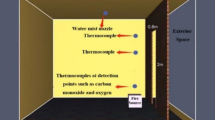Abstract
Water mist system is used widely in confined spaces, where fire protection and suppression efficiency is very important due to limited water and no water damage. Pulsed water mist is a new type of fire extinguishing system that sprays and pauses in cycle during the procedure of fire extinguishment. Focusing on the fire suppression performance of pause water mist system, a series of experiments have been conducted to explore a more effective pause cycle way, fire suppression behavior, and the temperature distribution in a confined space. The results can be found that the best fire extinguishing effect was achieved with a pulse cycle alternating between an 8-s activation and an 8-s deactivation. With the increase in size of the vents, the advantage of the pulse water mist system gradually diminishes. The smothering method is better than the cooling method. The results of the study may provide a reliable reference for the practical application of pulsed water mist system.









Similar content being viewed by others
References
Liu Z, Kim AK (1999) A review of water mist fire suppression systems—fundamental studies. J Fire Prot Eng 10:32–50
Santangelo Paolo E, Tartarini Paolo (2012) Full-scale experiments of fire suppression in high-hazard storages: a temperature-based analysis of water-mist systems. Appl Therm Eng 45–46:99–107
Kim SC, Ryou HS (2003) An experimental and numerical study on fire suppression using a water mist in an enclosure. Build Environ 38:1309–1316
Yang Peizhong, Liu Tao, Qin Xian (2010) Experimental and numerical study on water mist suppression system on room. Build Environ 45:2309–2316
Arvidson Magnus (2014) Large-scale water spray and water mist fire suppression system tests for the protection of RO–RO cargo decks on ships. Fire Technol 50:589–610
Ni X, Chou WK (2011) Performance evaluation of water mist with bromofluoropropene in suppressing gasoline pool fires. Appl Therm Eng 31:3864–3870
Tapscott RE, Sheinson RS, Babushok V, Nyden MR, Gann RG (2001) Alternative fire suppressant chemicals: a research review with recommendations. NIST Technol Note 1443:13
Soonil LM, Yang JC, Cleary TG (2003) On the interaction of a liquid droplet with a pool of hot cooking oil. Fire Saf J 38:651–659
Parra T, Castro F, Mendez C, Villafruela JM, Rodriguez MA (2004) Extinction of premixed methane-air flames by water mist. Fire Saf J 39:581–600
Prasad K, Li C, Kailasanath K, Ndubizu C, Ananth R, Tatem PA (1998) Numerical modeling of water mist suppression of methane-air diffusion flames. Combust Sci Technol 132:325–364
Liu Y, Jiang Z, Wang D, Xiaohui L (2014) Experimental research on the water mist fire suppression performance in an enclosed space by changing the characteristics on nozzles. Exp Therm Fluid Sci 52:174–181
Huang X, Wang XS, Liao GX (2002) Characterization of an effervescent atomization water mist nozzle and its fire suppression tests. P Combust Inst 33:2573–2579
Xiaomeng Z, Guangxuan L, Bo C (2006) Improvement of water mist’s fire-extinguishing efficiency with MC additive. Fire Saf J 41:39–45
Zhou Y, Rongwei B, Gong J, Yan W, Fan C (2018) Experimental investigation on downward flame spread over rigid polyurethane and extruded polystyrene foams. Exp Therm Fluid Sci 92:346–352
Silvani X, Morandini F, Dupuy JL (2012) Effects of slope on fire spread observed through video images and multi-point thermal measurements. Exp Therm Fluid Sci 41:99–111
Liu Z, Andrew KK, Su JZ (1999) Examination of the extinguishment performance of a water mist system using continuous and cycling discharges. Fire Technol 35(4):336–361
Jian L, Changkun C, Bingyin S (2014) Experimental study on gas temperature during fire in a compartment with a sloped roof vent. Fire Technol 50:1483–1498
Varri J (2001) A study of total flooding water mist fire suppression system performance using a transient one-zone computer model. Fire Technol 37:327–342
Honglin X, Xishi W, Yuan L, Pei Z, Haiyong C, Wenxin Q (2017) Experimental investigation of methane/coal dust explosion under influence of obstacles and ultrafine water mist. J Loss Prevent Proc 49:929–937
Liang TS, Liu MJ, Liu ZL, Zhong W, Xiao ZK, Lo SM (2015) A study of the probability distribution of pool fire extinguishing times using water mist. Process Saf Environ 93:240–248
Author information
Authors and Affiliations
Corresponding author
Additional information
Technical Editor: Mario Eduardo Santos Martins, Ph.D.
Publisher's Note
Springer Nature remains neutral with regard to jurisdictional claims in published maps and institutional affiliations.
Rights and permissions
About this article
Cite this article
Lun, P.Y., Zhang, Q. & Li, X.K. Experimental study on the pulse water mist fire suppression system performance in a confined space. J Braz. Soc. Mech. Sci. Eng. 42, 258 (2020). https://doi.org/10.1007/s40430-020-02354-x
Received:
Accepted:
Published:
DOI: https://doi.org/10.1007/s40430-020-02354-x



